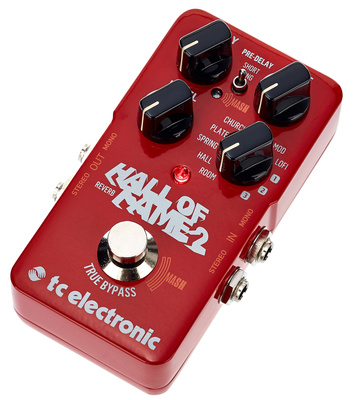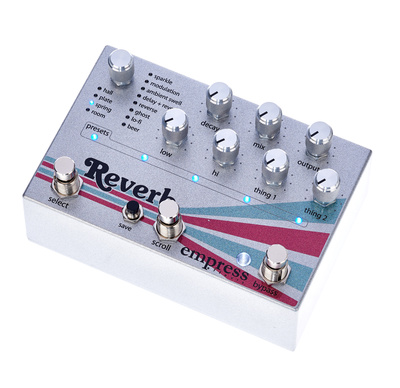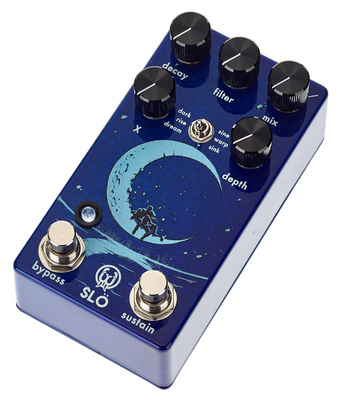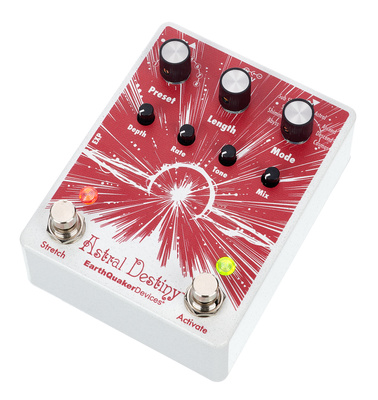The five best reverb effects
Reverb effects are an absolute classic on any guitarist's pedal board. In this article, we'll explain what reverb is and introduce you to our five favorite reverb pedals.
What is a reverb effect?
In English, "reverb" means "echo," which pretty much describes what you can expect from this type of effect. Reverb effects are now part of almost every song and have become indispensable to the music world. Therefore, a good reverb effect should not be missing from your setup.
Reverb effects are popular because they make your guitar sound more spacious and epic. Depending on the type of reverb and the pedal's settings, you can make your guitar sound as if it's playing in a large concert hall, a church, or even a stalactite cave. With the right reverb pedals, you can also elicit sounds reminiscent of an underwater landscape or outer space from your guitar.
How do reverb effects work?
Reverb effects simulate how your guitar would sound if you were playing it in a different environment. Suppose you were playing in an open field. Then your listeners would only hear the sound coming directly from you.
If you play in a closed room instead, your listeners will not only hear your direct sound, but it will also bounce off the surrounding walls. It is then reflected by them, changing the sound and causing it to arrive at the listener with a delay.
The greater the delay, the larger the acoustic space appears. For example, if you play in your bedroom, the sound travels such a short distance that there is hardly any audible reverb because the delay is not long enough. Of course, the situation is completely different in a concert hall or church.
Reverb effect pedals add reflections that are not actually present to your "dry" sound. You can then use the knobs on the pedal to adjust parameters such as the size of the room.
What types of reverb effects are there?
Not all reverb is the same. Below, we explain some common reverb categories that you will encounter time and again in effect pedals.
Analog Reverb: The first reverb devices were analog or mechanical. Examples include plate reverb, which uses vibrating metal plates to create reverb, and the reverb spiral, which works similarly but requires significantly less space. Today, there are digital simulations of all common analog reverb effects.
Acoustic reverb: It simply uses a physical room with the necessary sound characteristics. In this case, you play in a room that naturally produces reverb. However, this is not practical for most guitarists and is rarely used today. Nevertheless, many digital reverb effects are based on terms coined by this category. These include:
Room: A small room the size of a bedroom or living room
Chamber: A sound chamber used in recording studios
Hall: A concert hall
Cathedral: A cathedral or large church
Digital reverb: Most reverb effects today fall into this category. However, many of the digital reverb effects are still based on their analog or acoustic predecessors and therefore have names such as "plate," "spring," "room," or "hall."
Reverb and delay: What is the difference?
Reverb and delay are very similar in concept and are therefore often confused with each other. What they have in common is that they change the sound spatially. But these types of effects still sound very different.
As mentioned, reverb is a hall effect. It changes your sound as if it were being reflected by walls at varying distances. This in turn creates an illusion of width and spaciousness. This effect gives your music room to breathe, so to speak. Thanks to the hall effect, your guitar sounds fuller and your sound is less choppy and dry.
Delay, on the other hand, means delay. The idea behind it is that your guitar signal is played back again with a time delay. In principle, this is a simulated echo. The big difference between delay and reverb is that with delay you can actually hear the echo, while with reverb it is diffuse.
The 5 best reverb pedals
These five reverb effect pedals are our current favorites. It's not easy to narrow down the large number of available reverbs to such a small selection. That's because there are a lot of good reverb pedals out there. In this case, we made sure to include pedals from different categories. So these aren't necessarily the best-sounding reverb effects in absolute terms.
TC Electronic Hall of Fame 2
The Hall of Fame 2 is included in virtually every list of the best reverb effects. And we have to agree with this positive assessment. With the Hall of Fame 2, you get a lot for around $140.
First of all, the sound is really impressive. But the number of effects is also impressive. The Hall of Fame 2 has a knob for room size with eight preset settings. There are also three memory slots for your own creations, which can be filled via the app.
The device has a foot switch called MASH, which has several pressure levels and allows you to mix in the right amount of reverb. The Hall of Fame also supports true bypass.
The Hall of Fame is suitable for ambitious beginners and advanced players and, in our opinion, offers excellent value for money.
Strymon blueSky
Priced at just over €300, the Strymon blueSky focuses on quality rather than quantity. The device offers only three different reverb types, but they all sound absolutely fantastic. The reverb types can be further specialized via three modes.
In addition to decay and mix knobs, the blueSky also has a knob for pre-delay and a damp equalizer with one knob for highs and one for lows. A footswitch allows you to save your settings in a favorite slot or activate bypass mode.
The blueSky is interesting for advanced users and professionals who want excellent-sounding reverb but can do without gimmicks.
Empress Effects Reverb
At a hefty €450 to €500, the Empress Effects Reverb is definitely more for professionals. But for that money, you get a device with absolutely outstanding-sounding, flexibly adjustable reverb effects—and a whole lot of them.
In addition to the usual knobs for decay and mix, the pedal also has two equalizer knobs for highs and lows. The effects range from reverb to ambient swell to lo-fi. In total, the Empress pedal offers 32 different algorithms. You can also save your settings in 35 preset memory locations.
Like all devices from this brand, the reverb pedal from Empress Effects is an absolute professional device with, in our opinion, uncompromisingly good sound.
Walrus Audio Slö Multi Texture Reverb
Are you more into dark or dreamy soundscapes? Then the Walrus Audio Slö should be right up your alley. The reverb pedal has three effect types:
Dark: A dark, long reverb with an additional low octave
Rise: A swelling reverb
Dream: A reverb with additional vibrato
Just like the Hall of Fame 2, the Slö also supports true bypass. The Walrus Audio device offers plenty of adjustment options with five rotary controls, a toggle switch, and two footswitches. At a price of around 200 euros, the Slö is not one of the cheapest devices, but in our opinion, it is more than worth the money.
The Walrus Audio Slö is well suited for advanced players who like to play dark or atmospheric music.
EarthQuaker Devices Astral Destiny
The name says it all with the Astral Destiny from EarthQuaker Devices. Priced at around €200, this device isn't a jack-of-all-trades that can produce any reverb sound. Instead, it's a specialist for crazy shimmer sounds with names like "Abyss," "Astral," "Ascend," and "Cosmos."
This pedal's appeal isn't just limited to its unusual yet high-quality sounds. Designed by Marvel comic artist Matt Horak, it also looks stylish. Another interesting feature is the stretch footswitch, which doubles the reverb length and adds an adjustable pitch shift.
The Astral Destiny is perfect for advanced guitarists who enjoy playing mysterious and atmospheric music.
Conclusion
As we wrote in our guide to effects pedals, we believe that every guitarist needs a reverb pedal. If you're a beginner, you should get a suitable pedal right from the start. However, even experienced players and professionals may find it worthwhile to upgrade to a better device.
Whether you're a beginner or an advanced player, we hope this article has given you some ideas about which reverb pedal is right for you.




